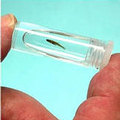 今(2006)年在婆羅洲的酸性黑水沼澤地發現一魚類新物種,這種魚類被列為世界上第二小的脊椎動物。因棲息地遭到破壞,其生存受到威脅,此種魚類只是科學家在東南亞島國新發現的52種動植物之一。
今(2006)年在婆羅洲的酸性黑水沼澤地發現一魚類新物種,這種魚類被列為世界上第二小的脊椎動物。因棲息地遭到破壞,其生存受到威脅,此種魚類只是科學家在東南亞島國新發現的52種動植物之一。
根據國際保育組織世界自然基金會(WWF)發表的新報告,發現的物種非常多,包含30個特有種的魚類、2種樹蛙、16種薑類,以及3種新種喬木。
「越深入調查我們發現到的越多,」世界自然基金會婆羅洲之心計畫國際協調員查普曼(Stuart Chapman)表示,「經由這些發現我們再度確認,婆羅洲是非常重要的一個世界生物多樣性中心。」
 位於整個婆羅洲島中心的婆羅洲之心,是一片22萬平方公里大的山區,全區都為赤道雨林所覆蓋。「這些雨林也非常重要,因為它們是所有主要河川的發源地,而且在今年摧毀低地的大火中,扮演著自然阻燃區抵抗火災的角色。」查普曼說道。
位於整個婆羅洲島中心的婆羅洲之心,是一片22萬平方公里大的山區,全區都為赤道雨林所覆蓋。「這些雨林也非常重要,因為它們是所有主要河川的發源地,而且在今年摧毀低地的大火中,扮演著自然阻燃區抵抗火災的角色。」查普曼說道。
保育人士多年來持續發出警訊,世界第三大島嶼婆羅洲可能會失去所有的低地森林,急需保護各類生物以及其棲息地。
由於種植橡膠、油棕以及製造紙漿等影響,已經使得婆羅洲的雨林有大片面積遭砍伐殆盡。世界自然基金會預估,婆羅洲約只剩一半左右的原生林存活下來。
新發現的迷你魚種,學名為Paedocypris micromegethes,比在蘇門達臘發現的其遠親P. progenetica稍微小一點,只有0.79公分,牠們是科學家已知最小的兩個脊椎動物。
 這種魚生長在南亞地區酸性極高的黑水泥媒沼澤中,只能在有森林遮蔽的區域裡生存,而非有陽光的區域。
這種魚生長在南亞地區酸性極高的黑水泥媒沼澤中,只能在有森林遮蔽的區域裡生存,而非有陽光的區域。
棲息地的破壞使得這些小魚的生存遭受威脅,由於伐木、都市化以及農業開發使用,特別是油棕的種植以及蝦養殖業等,造成南亞這些結構複雜的泥沼森林正快速消失。
2006年3月在巴西庫里奇巴所舉行的聯合國生物多樣性會議中,汶萊達魯薩蘭、印尼與馬來西亞三個婆羅洲國家,公開宣布保護並永續經營婆羅洲之心的承諾。現在保育人士希望他們能簽署一份正式的聯合聲明,以確保婆羅洲之心成為他們保育的首要工作。
A new species of fish, so tiny that it ranks as the world second smallest vertebrate, was discovered this year in Borneo's acidic blackwater peat swamps. Threatened by habitat destruction, this fish is just one of 52 new species of animals and plants that scientists identified on the southeast Asian island.
The discoveries, described in a new report by the global conservation organization WWF, include 30 unique fish species, two tree frogs, 16 ginger species, and three new species of trees.
"The more we look the more we find," said Stuart Chapman, WWF international coordinator of the Heart of Borneo Programme. "These discoveries reaffirm Borneo’s position as one of the most important centers of biodiversity in the world."
The Heart of Borneo is a 220,000 square kilometer mountainous region covered with equatorial rainforest in the center of the island. "These forests are also vital because they are the source of most of the island’s major rivers, and act as a natural "fire-break" against the fires that have ravaged the lowlands this year," Chapman said.
Conservationists have been warning for years that Borneo could lose almost all its lowland forest and that the need to conserve the habitat and species of the world’s third largest island is urgent.
Large areas of Borneo's rainforest are being cleared for rubber, oil palm and pulp production. Today, WWF estimates, only half of Borneo's original forest cover remains.
The miniature new fish species, Paedocypris micromegethes, is translucent in color and together with its slightly smaller cousin P. progenetica found on Sumatra, measuring 7.9 mm, represent the two smallest vertebrates known to science.
This fish is native to the very acidic, threatened, blackwater peat swamps of Southeast Asia, and was found only in shaded forested areas, not in light exposed open areas.
Habitat destruction jeopardizes the survival of these fishes. The structurally complex peat swamp forests are disappearing quickly in Southeast Asia, due to logging, urbanization and conversion for agricultural use, especially oil palm plantations and shrimp farms.
At a meeting of the UN Convention on Biological Diversity held last March in Curitiba, Brazil, the three Bornean governments - Brunei Darussalam, Indonesia and Malaysia - declared their commitment to support an initiative to conserve and sustainably manage the Heart of Borneo. Conservationists now hope that they will finalize a formal joint declaration to put the Heart of Borneo on the their list of top conservation priorities.






